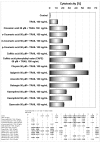Ethanolic extract of propolis (EEP) enhances the apoptosis- inducing potential of TRAIL in cancer cells
- PMID: 19223822
- PMCID: PMC6254026
- DOI: 10.3390/molecules
Ethanolic extract of propolis (EEP) enhances the apoptosis- inducing potential of TRAIL in cancer cells
Abstract
Ethanolic extract of propolis (EEP) is one of the richest sources of phenolic acids and flavonoids. EEP and its phenolic compounds have been known for various biological activities including immunopotentiation, chemopreventive and antitumor effects. Tumor necrosis factor related apoptosis inducing ligand (TRAIL) is a naturally occurring anticancer agent that preferentially induces apoptosis in cancer cells and is not toxic toward normal cells. We examined the cytotoxic and apoptotic effect of EEP and phenolic compounds identified in propolis in combination with TRAIL on HeLa cancer cells. HeLa cells were resistant to TRAIL-induced apoptosis. Our study demonstrated that EEP and its components significantly sensitize to TRAIL induced death in cancer cells. The percentage of the apoptotic cell after exposure to 50 microg/mL EEP and 100 ng/mL TRAIL increased to 71.10 +/- 1.16%. The strongest cytotoxic effect in combination with TRAIL on HeLa cells exhibited apigenin and CAPE at the concentration of 50 microM (58.87 +/- 0.75% and 49.59 +/- 0.39%, respectively). In this report, we show for the first time that EEP markedly augmented TRAIL mediated apoptosis in cancer cells and confirmed the importance of propolis in chemoprevention of malignant tumors.
Figures







Similar articles
-
Polyphenols Isolated from Propolis Augment TRAIL-Induced Apoptosis in Cancer Cells.Evid Based Complement Alternat Med. 2013;2013:731940. doi: 10.1155/2013/731940. Epub 2013 Mar 19. Evid Based Complement Alternat Med. 2013. PMID: 23573148 Free PMC article.
-
Ethanolic extract of Brazilian green propolis sensitizes prostate cancer cells to TRAIL-induced apoptosis.Int J Oncol. 2011 Apr;38(4):941-53. doi: 10.3892/ijo.2011.930. Epub 2011 Feb 1. Int J Oncol. 2011. PMID: 21286663
-
Ethanolic Extract of Propolis Augments TRAIL-Induced Apoptotic Death in Prostate Cancer Cells.Evid Based Complement Alternat Med. 2011;2011:535172. doi: 10.1093/ecam/nep180. Epub 2011 Jun 7. Evid Based Complement Alternat Med. 2011. PMID: 19892808 Free PMC article.
-
The role of dietary polyphenols in tumor necrosis factor-related apoptosis inducing ligand (TRAIL)-induced apoptosis for cancer chemoprevention.Eur J Cancer Prev. 2011 Jan;20(1):63-9. doi: 10.1097/CEJ.0b013e32833ecc48. Eur J Cancer Prev. 2011. PMID: 20861738 Review.
-
TNF-related apoptosis-inducing ligand: signalling of a 'smart' molecule.Int J Biochem Cell Biol. 2009 Mar;41(3):460-6. doi: 10.1016/j.biocel.2007.12.012. Epub 2007 Dec 28. Int J Biochem Cell Biol. 2009. PMID: 18243765 Review.
Cited by
-
Polyphenols Isolated from Propolis Augment TRAIL-Induced Apoptosis in Cancer Cells.Evid Based Complement Alternat Med. 2013;2013:731940. doi: 10.1155/2013/731940. Epub 2013 Mar 19. Evid Based Complement Alternat Med. 2013. PMID: 23573148 Free PMC article.
-
Is propolis safe as an alternative medicine?J Pharm Bioallied Sci. 2011 Oct;3(4):479-95. doi: 10.4103/0975-7406.90101. J Pharm Bioallied Sci. 2011. PMID: 22219581 Free PMC article.
-
A Comprehensive Approach to Derivatization: Elemental Composition, Biochemical, and In Silico Studies of Metformin Derivatives Containing Copper and Zinc Complexes.Molecules. 2023 Feb 1;28(3):1406. doi: 10.3390/molecules28031406. Molecules. 2023. PMID: 36771070 Free PMC article.
-
Novel Structurally Related Flavones Augment Cell Death Induced by rhsTRAIL.Int J Mol Sci. 2017 Jun 6;18(6):1211. doi: 10.3390/ijms18061211. Int J Mol Sci. 2017. PMID: 28587286 Free PMC article.
-
A comparative UHPLC-QTOF-MS/MS-based metabolomics approach reveals the metabolite profiling of wolfberry sourced from different geographical origins.Food Chem X. 2024 Feb 10;21:101221. doi: 10.1016/j.fochx.2024.101221. eCollection 2024 Mar 30. Food Chem X. 2024. PMID: 38379804 Free PMC article.
References
-
- World Health Organization: Cancer. 2006.
MeSH terms
Substances
LinkOut - more resources
Full Text Sources
Other Literature Sources

